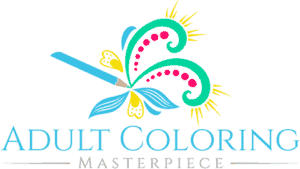Adult coloring is relaxing, fun, and stress-free. Whether you’ve been coloring for a while or are new to adult coloring books, there are tools, tips, techniques, and tricks of the trade that can take your coloring to another level.
Setting aside time in your day or week to color permits you to detox from all things digital – phones, social media, 24-hour news feeds. It allows an adult time to meditate and focus on something creative for an extended amount of time.
Tools

Most adults find that colored pencils are their preferred medium of choice. Easy to correct and erase, colored pencils are forgiving. There are thousands of options available; however, artists often have favorite brands. If you’re looking to layer or enhance color pallets, more massive colored pencil sets usually include lots of pencils in the same shade or color family. This makes layering colors in the same shade much more manageable and gives real depth to your piece. Beginners may want to start with a small set of 12-24 pencils, and that’s alright, too.
For those who go one step further, pens are an excellent way to highlight and intensify your work. Gel pens, especially, offer neon colors, metallics, and even glitter pens that can be used for accents and highlights. Remember, though, that pens are permanent. It’s often hard and usually frustrating to try and make corrections to pen ink.
Water-based markers are another popular tool in the adult coloring book toolkit. Markers are much easier on the hands and fingers, so markers are a more comfortable medium for people with carpal tunnel syndrome or arthritis. Dual-tip sizes are especially crucial for filling in color and are great for filling in larger spaces, too. One downside to markers is that they bleed, so don’t use them on a page if your heart is set on coloring both sides.
Eyeshadow brushes and eyeshadows are a fun but unexpected tool that can help color skin tones, which can be tricky to get right. If your eyeshadow is too expensive to use in a coloring book, try PanPastels. They’re not great for tiny areas but are excellent for large areas like the sky, ocean, or general backgrounds.
White gel pens can help correct mistakes. They also add highlighted accents. Interestingly, you can add shadows and darker tones with charcoal.
Art supply store staff are an excellent resource for advice and suggestions. Make some time to ask your questions, try out samples, and then settle on the tools you think will bring the most joy without putting a dent in your budget. This is a hobby, so you can spend as much or as little as your budget comfortably allows.
Tool Care
If you invest in a large, quality set of colored pencils, you will want to take care of your investment. The good news is that colored pencils are more durable and less fussy than many other mediums.
If you purchase your pencils from an art store, they will likely come in a storage case. Keep your pencils in their original case, and be sure to store them in a cool, dry place. Direct sunlight, heat in general, is detrimental to the waxy-colored pigment inside the pencil, so cool and dry is best.
Try not to drop or knock your pencils off your drawing surface. The color is notorious for breaking inside the wooden pencil, preventing a good, clean sharpening.
Sharp pencils make for excellent detail work. The sharper the pencil, the better the pigment and the bolder the color. Plus, the sharper the tip, the more detailed you can be. We recommend a good, old-fashioned, economical hand-held pencil sharpener dedicated to your colored pencils. The best kinds are the ones that have openings for pencils of different sizes. These smaller sharpeners can allow you to color the muse calls anytime!
If you choose to add gel pens to your repertoire, be sure to keep the caps on your pens when not in use. The ink inside a gel pen is pigment suspended in a jelly-like substance. This jelly-like substance, the thing that makes us love gel pens as much as we do, dries out quickly, so for the sake of longevity, keep them capped.
Techniques

Practice makes perfect. It’s not just an adage; it’s true. The more you color, the better you will be at coloring. Keep in mind; that you’re doing this because it’s fun and you enjoy it! Don’t get so focused on perfection and techniques that you begin to add stress to your experience. Have fun! Experiment! It’s art. In art, there are no mistakes.
Color in the more prominent areas on your page first. Move from biggest to smallest, developing your palette as you go. The most intricate work should be done last. This allows you to choose colors that complement each other – with accents being the last addition to the piece. For example, if you’re working on a landscape, color in the sky, or shoreline first. With lots of layered colors, those more significant pieces will help unify the piece and determine your accent color choices.
Want to know even more techniques to get you started? Check out our article 5 Colored Pencil Marking Techniques to learn more!
Vary your stroke pattern. Don’t color all your shapes with vertical strokes of the pencil. Try variations like horizontal or diagonal. You may even choose to stipple. Stippling is when you color inside a shape by using a series of small dots on a page. Stippling can draw the eye and give variation in texture. To start, be uniform in your stroke patterns. For example, if coloring a garden piece, perhaps all the roses are colored and layered in horizontal layers, but all the daylilies are stippled.
Try pressure shading, a technique that adds depth to your work. Practice pressure shading by penciling in light-to-dark swatches of the same color on a piece of scratch paper. This is an excellent technique for practicing different levels of lighting. Remember, areas in the light are brighter than areas further away from the light.
Apply brighter colors first when blending. Dark pigments show up quickly on lighter colors, but not necessarily the other way around. When blending color, create several evenly spaced blocks of color, each a little different. That way, you make lots of small, simple blends rather than one big block of color.
Want to learn more about coloring with markers like a pro? Check out How to Color with Markers WITHOUT Streaks!
Tricks of the Trade
Slow down. Adult coloring is fun. Enjoy yourself. Experiment with styles. Relax.
Don’t put undue pressure on your wrists. Gripping the pencil farther from its base allows for broader coverage, lighter strokes, and a relaxed hold. You’ll want to start with lighter colors and gradually build darker. Gripping closer to the base of the pencil will darken the colors.
As you put the finishing touches on a piece, try integrating layers more thoroughly using a colorless blending pencil (usually sold separately.) Pro-tip: Warm the pencil’s tip by wrapping your fist around the top for a minute or so before using it. This technique makes the blending pencil a little softer and easier to use. Practice on a scratch piece if you’re unsure about the finished product.
Dab a Q-tip or finely tipped paintbrush in a sparse amount of baby oil and gently brush over your pencil strokes for a paint-like finish. Use enough oil, and you can manipulate the color and blend it almost like a watercolor. Pro-tip: Try this out on a scratch piece of paper first, so you get a good feel for how much baby oil is too much.
Ready to start coloring like a pro? Click here to download my free adult coloring eBook and sign up for my email newsletter!
Disclaimer: The information provided by ColoringMasterpiece.com (“The Site”) is for general informational purposes only. All information on the Site is provided in good faith, however, we make no representation or warranty of any kind, express or implied, regarding the accuracy, adequacy, validity, reliability, availability, or completeness of any information on the Site. Under no circumstance shall we have any liability to you for any loss or damage of any kind incurred as a result of the use of the Site or Reliance on any information provided on the Site. Your use of the Site and your reliance on any information on the Site is solely at your own risk. This blog post is for educational purposes only and does not constitute legal advice. Please consult a legal expert to address your specific needs.
Terms and Conditions: https://coloringmasterpiece.com/terms-and-conditions/
